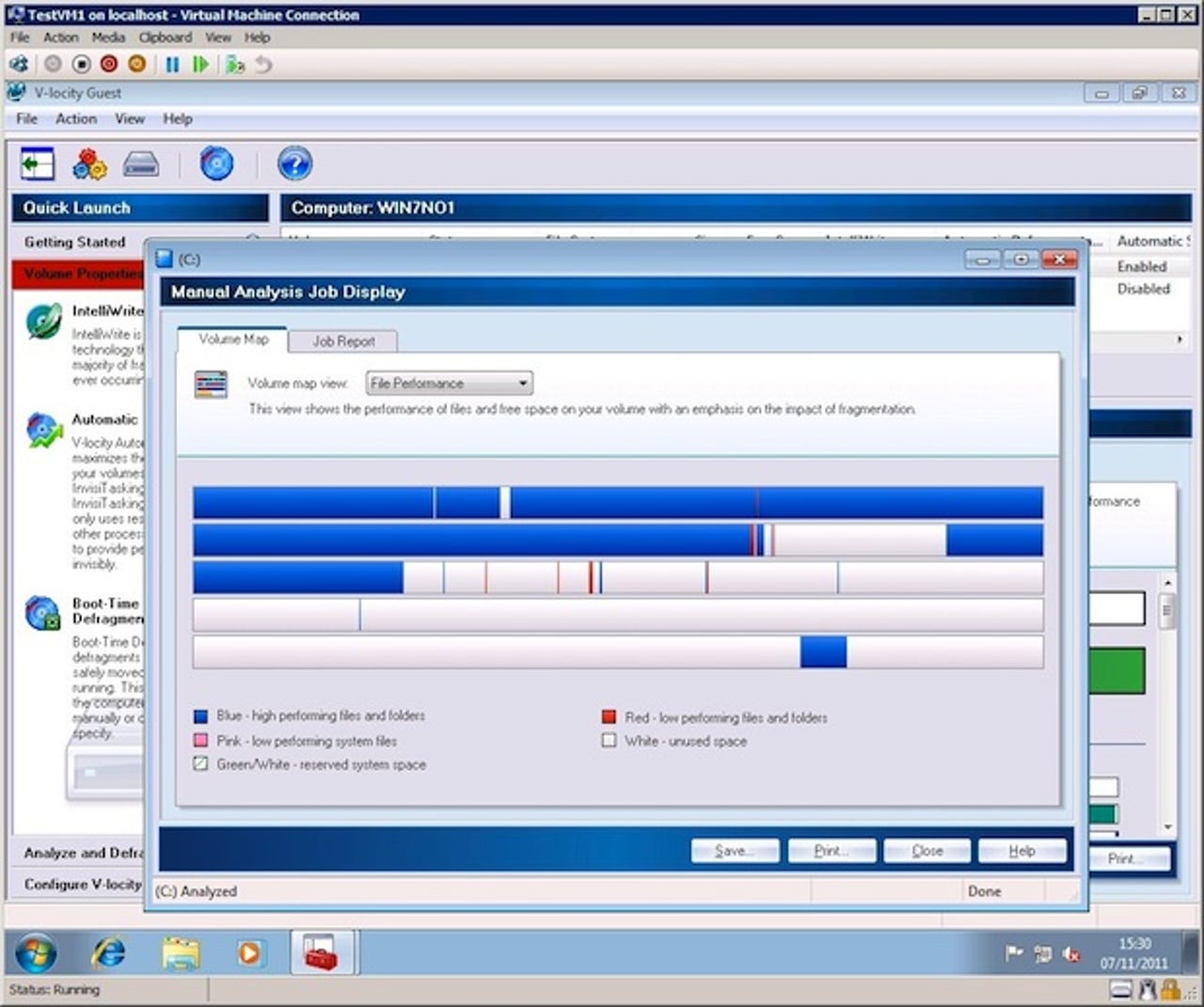V-Locity 3

V-Locity 3

According to defragmentation specialist Diskeeper, fragmented files can still cause performance issues — even in modern virtualised environments and on storage area networks (SANs). However, the need to manually 'defrag' could be a thing of the past — at least for companies with virtual machines running Diskeeper's V-Locity 3. This "virtual doctor for virtual platform optimization", Diskeeper claims, can stop file fragmentation in its tracks, before it occurs.
Designed for both VMware and Microsoft Hyper-V platforms, there are two parts to the V-Locity 3 product, starting with a V-Locity guest that needs to be installed and configured on every virtual machine (VM).
It's this bit of software that does the defragging work. There are no specific virtual hardware requirements, but VMs must be running Windows (either 32-bit or 64-bit) — XP, Vista and Windows 7, along with Windows Server 2003 and above, are supported.
The second component coordinates activities, working out what kind of virtual disks are involved and making sure that defragging in one VM doesn't affect the performance of others. The latest V-Locity 3 release also features a technology called CogniSAN, which enables the software to detect resource usage on a storage network and stop V-Locity guests competing for resources against others using the same infrastructure.
That inevitably requires the ability to see and talk to the VM guests, and there are different host requirements depending on whether you're running VMware or Hyper-V.
With the Microsoft hypervisor, for example, the V-Locity 3 host application can simply be installed on the same Windows Server 2008 R2 box as Hyper-V. For those running VMware, however, a separate host agent is required, loaded onto any Windows machine (physical or virtual) that can communicate with both the V-Locity guests and the VMware hypervisor (ESX/ESXi) or its vCenter controller.
This sounds complicated, but there's a straightforward Windows setup routine with no rebooting required, which will please administrators of production systems.
For our tests we opted for Hyper-V, manually installing the V-Locity guest into a newly configured Windows VM and then cloning that machine to populate our environment. For existing sites with hundreds of VMs, that's not a workable approach, so the guest software can also be installed using third-party distribution tools or Diskeeper Administrator (£202.89 ex. VAT), which can also be used to centralise guest monitoring and management.
Once installed, V-Locity 3 starts working straight away, its new IntelliWrite technology being turned on by default to prevent files being fragmented as data is written to disk. According to Diskeeper, this should prevent the majority of fragmentation from occurring, but it can't catch everything. To that end, there are additional defragmentation layers to catch files that are still broken up, and consolidate them after the event.
A lot of this later defragging can also be done on-demand — by what's called the InstantDefrag engine. There's also a batch defragger that gets automatically scheduled to mop up any final stragglers.
On our Hyper-V setup this combination successfully kept our virtual disks clear of fragmentation except in the most extreme test conditions, which are unlikely to be met in practice. We ran a file fragmentation utility that, on identical machines without V-Locity installed, soon became littered with fragmented file blocks — something we were able to verify using the graphical analysis tool also available from the V-Locity console.
V-Locity 3 provides plenty of tools to check on defragmentation activity, including historical reports and real-time graphs
We were particularly impressed by the way V-Locity 3 went about its business, keeping our storage tidy with minimal impact on hypervisor or VM performance and with little need to monitor what it was up to. That said, a number of tools are provided to check on activity, including historical reports and real-time graphs showing how much fragmentation has been prevented and the virtual resources used to achieve those results.
We did have a few issues when our virtual disks started to fill up. For example, the V-Locity guest disabled itself because it didn't have enough space to work in. That's understandable, but it would be nice to be alerted.
Some users may find V-Locity 3's console interface cluttered — we found it necessary to disable the quick-launch pane, for example
The console interface also had its idiosyncracies. Some tools could be accessed in several different ways, for example — from the menu bar at the top of the screen or from a row of icons at the top of the window, or via a quick-launch pane. Some users may like having all these options, but we found it both cluttered and confusing, and ended up disabling the quick-launch pane.
It took a while for some of the statistics to be refreshed, which was annoying. We also found it necessary to turn off the initial on-screen report, which displays every time the console is started. Although it's useful to start with, we found this report more of an irritant than an aid on a host with lots of VMs to manage.
Another concern is the necessity to run the console and manage each V-Locity guest individually. Fortunately the V-Locity software looks after itself much of the time, and central monitoring and management is possible if you add Diskeeper Administrator. It's just a shame this option doesn't come as standard.
V-Locity 3 supports volumes with Microsoft's Volume Shadow Copy Service (VSS) enabled
Other features worth mentioning include support for Windows VSS and virtual disks that have been thin provisioned. V-Locity 3 also offers automatic space reclamation, including on-the-fly compacting of space during live migration of virtual machines. It's not expensive either, with per-core licensing that applies regardless of how many VMs are being hosted (V-Locity 3 costs from £137.50 ex. VAT per hypervisor processing core for 1-24 cores). Finally there's a free 30-day trial, so you can check out exactly what the software can do and whether it suits your way of working.